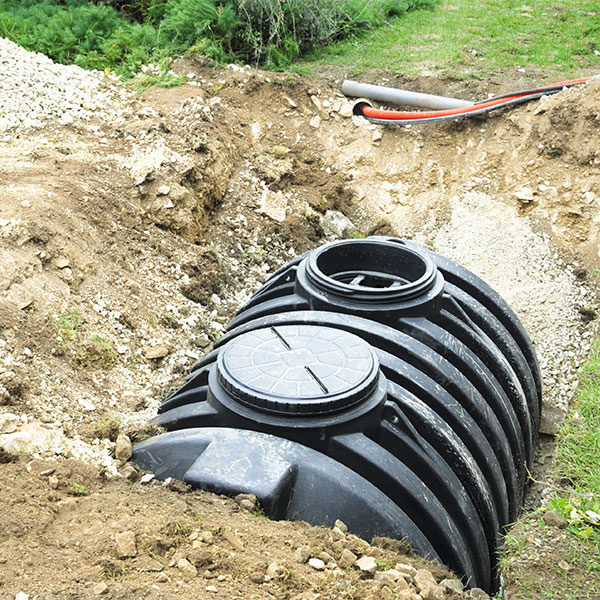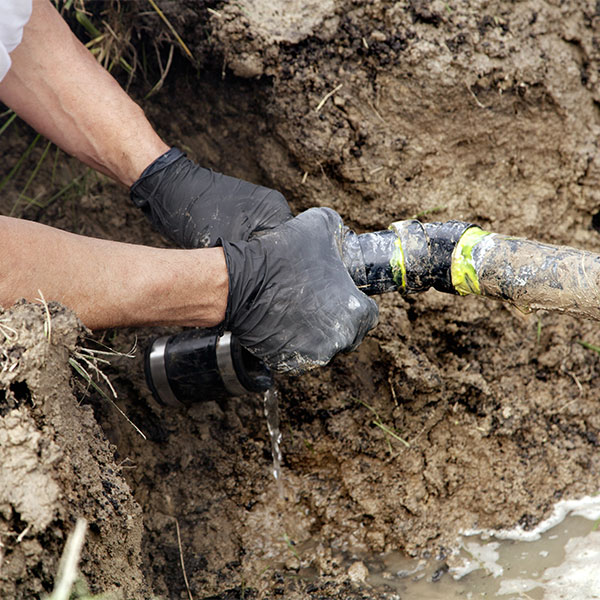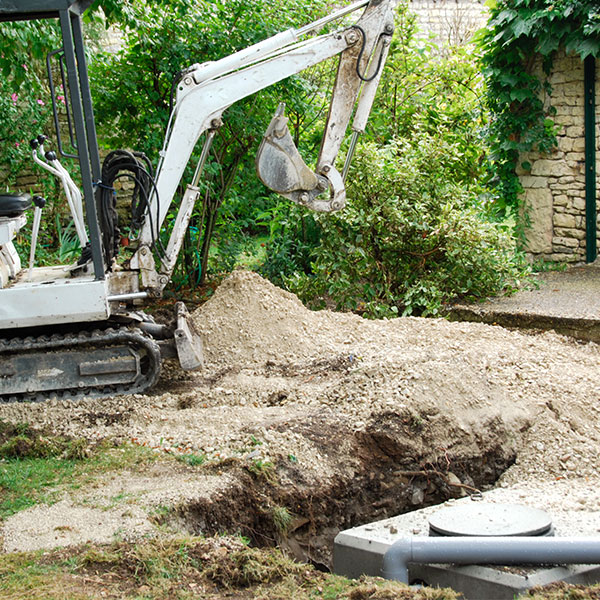Find a local septic tank installer or cleaner
This page has everything you’ll need to know about finding and hiring a local septic tank specialist.
Post your job for free. Read reviews, get quotes, and see tips on hiring the right person.
Browse Septic Tanks - Installation / Emptying / Cleaning specialists
Take a look at our Septic Tanks - Installation / Emptying / Cleaning specialists profiles, read reviews and request quotes directly.
Septic Tank Emptying, Installation & Cleaning | Find a Septic Tank Service Near You
What is a septic tank?
A septic tank is a type of sewage system for the home, and is generally used in rural properties that can’t be connected to a larger sewer system.
How does a septic system work?

All sewage and wastewater leaves the house via a main pipe, and goes into the septic tank which is buried underground. The tank is usually made of concrete, fibreglass, PVC, or plastic.
Inside the tank, solid waste sinks to the bottom and is partially decomposed by bacteria. Other elements like fat and plastics rise to the top, creating a crust. What’s left in the middle is relatively cleaner water – and we stress the word ‘relative’ here. It’s a long way from being drinking water, but it can be drained into the ground, which disposes of it naturally in the local ecosystem, rather than contributing to the work of a large sewage facility.
When the water leaves the septic tank, it goes into a distribution box. This box feeds the water into a set of underground pipes, which then releases the water into the soil. The ground above these pipes is known as the draining field or soakaway.
The whole system can easily work using gravity, with each component being lower than the last, but if this isn’t possible then pumps can assist in getting the water where it needs to go.
Some water evaporates into the air, and the rest soaks down into the soil. The soil itself filters out chemicals and minerals, while microbes in the soil break down impurities in the same way the septic tank does.
Releasing water back into the ground keeps it moist, and helps plants grow.
The system also requires a vent to release noxious gasses from the septic tank, as well as allow air into the system.
What can a septic tank specialist help with?
Cleaning
The most important thing you’ll need a septic tank specialist for is to clean out the system. The solids at the bottom of the tank, as well as the crust at the top, build up faster than it decomposes. These elements need to be removed from the tank periodically, which is why the tank has access hatches built in. About once a year, you’ll need to arrange for someone to pump out the excess waste. If this is ignored, then the waste will build up and eventually block, backing up into the house.
Installing or replacing a septic tank
Over time, you might need to replace parts, or all, of a septic system. If the system requires cleaning every few months then that’s a sign of blockage or inefficiency. Maybe you can see waste water or sewage coming up from the ground, which could be a sign that the tank is no longer watertight. These are severe cases but they’re the biggest reasons why you might need to replace the system.
You might have a large house with a lot of water usage, in which case you could consider a larger tank. It’s also possible to link two or more tanks together if you need larger capacity.
Costs for septic tank installations and maintenance
- Tanks start at around £800.
- Installation is around £1500.
- The drainage field, or soakaway, costs about £5000 to lay, for about 100 metres of drains. This is the total length of the pipes – you don’t need a 100-metre stretch of land to accommodate it.
- Emptying the tank annually will cost around £150.
Maintenance of your septic tank system
If you want to maintain your system in the best possible way, there are 3 things you need to know.
How the system works.
Everything happens underground and out of sight, so it’s important you know what’s going on. This page tells you everything you need to know, so you’ve got that covered.
Where the pipes are.
If you’re installing a septic tank system, get your installer to show you where everything is, plus you should always keep plans of the work for future reference. If you’re buying a house that already has a system installed, you should ask for the plans. If they’re not available then use a septic tank specialist to help you find out where everything is.
Potential ways you could damage the system.
You shouldn’t build anything on top of the drainage pipes. If you put any sort of shed or building on top of the pipes, you’re almost definitely going to cut or damage them. Also it stops air from getting into the soil, which would hinder the soil’s ability to filter the water.
Likewise, don’t drive over the pipes, or park a vehicle there. This weight will compact the soil and stop it from being able to accept water at all. In severe situations, the weight of a car could even crush the pipes. You shouldn’t keep large animals there – like horses or cows – for the same reason.
Don’t pour waste chemicals, paints, or cooking oils down the sink. These can kill the microbes in the septic tank that break down the solid substances. They can also clog the drainage field which would eventually fill the tank, and back up into the house.
Always know where your access hatches are too, and keep them clear of obstruction.
Lastly, don’t plant any trees or bushes too near the system as the roots could disturb the pipes too.
8 things to check when buying a property with a septic tank
- Ask if the septic tank has been maintained regularly – ask for invoices or receipts for tanker visits or service calls. A septic tank usually needs to be emptied annually.
- Find out how often the system is currently being emptied. If it’s being emptied every few months, this could be a sign of a problem.
- Ask the current owners how much their service costs, so you can work out how much it’ll cost you annually.
- Don’t rely on homebuyer surveys to tell you what’s going on underground – they only take a basic look at drainage systems. It’s crucial you get a full pre-purchase drainage survey before buying somewhere with a septic system. Get the tank emptied at the same time, to make sure the walls and pipework of the tank can be inspected.
- Ask for a plan of the drainage system.
- Find out if any part of the system is on someone else’s land. You need to know what the relationship is like with the landowner as you’ll need access for repairs, replacements and maintenance.
- Think about access to the property. Tankers need to be within 30 metres of the tank to empty it. Are you planning an extension or similar? If so you’ll need to make sure this access is maintained.
Where does the waste water go when it leaves the tank? If it goes straight to a watercourse or a ditch, this isn’t legal any more. By 2020, you’ll need to have it
Planning permission for septic tanks
If you’re installing a new septic tank system
For installations in England, you need planning permission and building regulations approval.
There are different rules for septic tanks and treatment plants in Northern Ireland, Scotland and Wales.
If you have a system that didn’t get permission and approval
In England, you need to apply retrospectively for both planning permission and building regulations approval.
You don’t need to do this if your system was installed before 1 January 2015.
Regulations for operating a septic system
You must follow the general binding rules if you’re the operator of a septic tank or small sewage treatment plant.
The sewage must:
- Be domestic, for example – from a toilet, bathroom, shower or kitchen of a house, flat or business – contact the Environment Agency if you’re not sure if the sewage is classed as domestic.
- Not cause pollution – find out how to check for pollution.
There are other rules depending on whether you’re releasing sewage to the ground, or into surface water.
Releasing to the ground
You have to use a septic tank or a small sewage treatment plant and a drainage field (infiltration system).
You need to apply for a permit if you release (‘discharge’):
- To a well, borehole or other deep structure.
- More than 2 cubic metres (2,000 litres) per day.
- In a groundwater source protection zone (SPZ1).
Releasing to a surface water
You must use a small sewage treatment plant. You must apply for a permit if you’re discharging more than 5 cubic metres (5,000 litres) per day. Use the calculator to work out how much you discharge per day.
Find out more on the government’s website.
Insurance for skill work
All tradespeople should have public liability insurance, which protects you, and them, against any accidents or injury.
AC BC Construction
Septic Tanks - Installation / Emptying / Cleaning
AC BC Construction is a new business with a lot of experience within the construction industry. The team is made up of a farther and son team ( both have over twenty years experience) & many connections to many trades. Building & Landscaping projects
P.F.SORICI LTD CONSTRUCTION
Septic Tanks - Installation / Emptying / Cleaning
Boothams of York
Septic Tanks - Installation / Emptying / Cleaning
Court Building services
Septic Tanks - Installation / Emptying / Cleaning
M Cochrane
Septic Tanks - Installation / Emptying / Cleaning
k.c.s
Septic Tanks - Installation / Emptying / Cleaning
Matt Weller
Septic Tanks - Installation / Emptying / Cleaning
Charlan Ltd
Septic Tanks - Installation / Emptying / Cleaning
First Choice Property Services
Septic Tanks - Installation / Emptying / Cleaning
K2 Services
Septic Tanks - Installation / Emptying / Cleaning
Partners Construction Ltd.
Septic Tanks - Installation / Emptying / Cleaning
Elegance
Septic Tanks - Installation / Emptying / Cleaning
Austin Building & Carpentry
Septic Tanks - Installation / Emptying / Cleaning
Allstarconstruction
Septic Tanks - Installation / Emptying / Cleaning
Matrix Design & Build
Septic Tanks - Installation / Emptying / Cleaning
JOHN'S JOINERY
Septic Tanks - Installation / Emptying / Cleaning
Derek Walker Joinery ltd
Septic Tanks - Installation / Emptying / Cleaning
Amr construction
Septic Tanks - Installation / Emptying / Cleaning
AKZ Building Services Limited.
Septic Tanks - Installation / Emptying / Cleaning
G Todd Plumbing & Heating Services
Septic Tanks - Installation / Emptying / Cleaning
Gas Safe Registered, Snipef Licensed, Water Safe Registered
Get our app for homeowners
- Send messages and get notifications from tradespeople
- Add photos to get more accurate quotes
- View tradespeople's profiles



